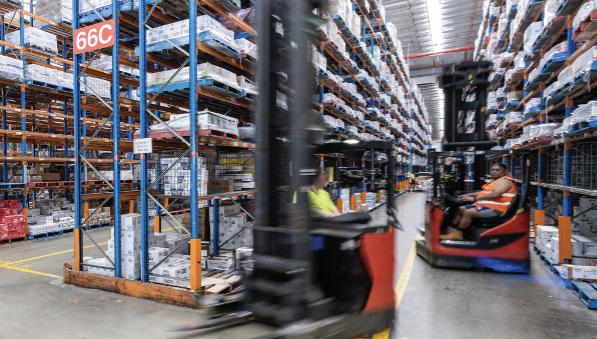
6 minute read
Industry News
from MHD Apr 2022
by Prime Group
Asia’s supply chains growing to become world’s biggest
According to Cushman & Wakefield’s report The Role
of Asia Pacific in Global Supply
Chains, South-East Asia and India will have major global supply chain networks in a decade’s time.
Cushman & Wakefield note Asia’s role in global trade has changed over the past two years as the pandemic has disrupted supply chain networks, which has affected the flow of trade globally.
It says corporations are now reconfiguring and building their logistics and industrial networks in the region.
“As the world economies recover and businesses look for effective ways to address supply chain volatility, there is greater emphasis on being more resilient and designing flexible, responsive, and efficient supply chain networks in the region to cater to regional needs,” Tim Foster, Head of
Supply Chain & Logistics Advisory, Asia
Pacific at Cushman & Wakefield says.
“The rising ‘Asia for Asia’ approach sets the stage for the growth of supply chain networks in the region, particularly in South-East
Asia and India, and also highlights the critical factors that contribute towards the optimisation of these networks,” Tim adds.
The report also notes Asian consumers are expected to buy more products that are manufactured in
Asia, and the robust economic and demographic growth prospects for the region supports this.
It says Asia is expected to account for over 40 per cent of global economic output, 54 per cent of the global population, and 65 per cent of the global middle class by 2030.
It also anticipates trade in Asia will grow because of these changes and will shape the design of its supply chain networks and says the region will manufacture more technology-based products as its population increases over the next decade.
“Asia will continue to be a key source of finished goods for global markets,” Tim says.
“The manufacture of components and sub-assemblies will increase in markets like Vietnam, Indonesia and India, and these markets will move up the value chain and begin producing more finished goods as China’s capacity is taken up with servicing domestic demand,” he adds.
“Food and beverage will drive growth in intraregional trade given their perishable nature and the need for cold chain integrity and traceability, with Indonesia, Vietnam, Philippines, and Malaysia being key markets.”
Cushman & Wakefield says businesses whose supply chains are being impacted by COVID-related pressures should experience some reprieve towards the end of this year.
It also notes that demand for logistics and industrial real estate is affected by supply chains when they are being designed and configured as well as by megatrends in demographics, urbanisation, technological advances, and structural shifts and disruption.
According to the report, online retail’s growth has caused e-commerce networks to expand, which has required warehousing space in major metropolitan areas with reliable transport.
It says newly developed warehouses must adopt technology, automation, and predictive analytics to deliver goods to consumers, so the buildings have more space for incoming orders.
With suppliers being required to provide information on their health, safety, labour, and environmental practices, transparency and sustainability are becoming important, the report says.
It also states these affect the supply chain as corporations try to meet their own Environmental, Social and Governance targets.
Cushman & Wakefield says it has identified three key real estate considerations that can be used to optimise Asian supply chains: network configuration, facility location and building specifications.
It comes as the company notes the rising cost of industrial property and that approximately 80 per cent of the value of a supply chain network is locked in at the design stage.
“Corporations need to focus on building resilience and flexibility into the supply chain,” Tim says.
“From a real estate perspective, zthe implications for industrial property abound, but it is important to remember that real estate demand is the product of supply chain optimisation,” he adds.
“The key is to first design the optimal supply chain network, then execute on real estate requirements. Bringing these factors together in a coherent way provides the strongest approach to navigate short-term and longerterm transformation.
Female managers leading charge at CouriersPlease
Three female state managers at CouriersPlease (CP) are leading the company throughout the pandemic, during which time it has seen a 15 per cent increase in year-onyear parcel deliveries since March 2020.
Tracey Baldwin, Queensland State
Manager, Lisa Tedstone, South
Australia State Manger and Kristy
Wright, Western Australian State
Manager are in an industry where 78 per cent of workers are men.
At CP, 50 per cent of the leadership team are women, including Tracey,
Lisa, and Kristy.
Each manager is responsible for all areas of the business in their state, from the management of parcel delivery volumes to performance and recruitment as well as profit and loss, process improvement and safety.
Tracey, Lisa, and Kristy have ensured millions of parcels have been delivered to households across Australia while also keeping essential workers safe and COVID-free across seven national depots.
Tracey is CP’s first female and longest-serving state manager.
She directs a team of 10 operational managers and is responsible for over 220 franchisees and 75 staff across five depots.
“Safety is an important priority for me in my role, and I regularly visit each depot across the state to ensure we’re addressing any potential safety risks,” Tracey says.
“For instance, I’ve championed the introduction of exclusion zones in our five depots,” she adds. “These zones identify high-risk areas, often where forklifts and other machinery are in use to help reduce incidents.”
During her tenure, Queensland has experienced a 35 per cent yearon-year growth in parcel volumes.
She improved the state’s linehaul utilisation by 10 per cent year-on-year, and helped it achieve a consistent 96 to 97 per cent rate of on-time deliveries.
Lisa Tedstone leads a team of 35 staff and 64 franchisees in SA.
She’s one of CP’s longest-serving operational personnel. She joined the company in 2009 as a customer service representative and worked her way into operational leadership roles.
She’s ensured CP in SA has consistently maintained a 96 to 97 per cent rate of on-time deliveries and delivers more items per courier than any other state. The SA branch has seen almost a 40 per cent increase in parcel volumes and increased its franchisees by 36 per cent.
Lisa helped lead national programs at CP and prepared it to deliver its highest parcel volumes during last Christmas’ peak period.
She also equipped the company’s drivers across Australia with new scanner devices. This technology allows customers to receive delivery notifications and includes route optimisation for faster parcel delivery.
Kristy leads a team of 20 staff and 60 drivers, 10 of which are smallbusiness franchisees. She has 15 years’ experience in the logistics industry, having started her career as a courier driver.
During her tenure, WA has experienced a 30 per cent increase in the Christmas peak period –it was the busiest ever in her career.
“I’m very proud to be part of the team at CP,” Kristy says. “It’s the first time in my management career that female leaders outnumber male leaders.”
“I’ve achieved enormous improvements in productivity and performance – including on-time deliveries – and we now have the highest staff engagement rates since I’ve started,” she adds.
“I anticipate that we will continue experiencing exponential growth over the next two years.”











